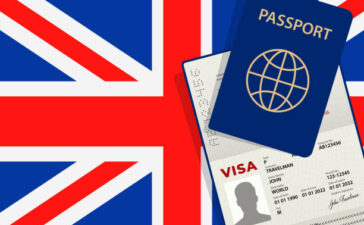The desire to enjoy the American dream, pursue different career opportunities, as well as experience various cultures has led to an increase in the process of US visas for foreigners. However, understanding the complexity of these procedures is essential if you’re planning a trip to the US. To live, study, or work in the US, you must apply for and obtain a US visa, although it can be a complicated and demanding process.
Advertisement
There are eligibility criteria that you must meet, as well as various documents that you will submit. In this article, we’ll provide a comprehensive guide on how to navigate the process of US visas. Also, a detailed insight into the various types of US visas, the visa application processing, and some tips to successfully obtain a visa. Let’s dive in!
What is a US Visa?
A US visa is an authorization often issued by the US government for foreigners to enter the United States. In other words, it’s a permit that grants non-citizens entry into the country for specific purposes like work, study, or tourism. Furthermore, this authorization is usually attached to your passport before you can enter the United States.
To apply for a visa, you must fill out application forms online, provide the appropriate documents, and pay a fee. But in some cases, you may need to attend an interview at the US embassy or consulate.
US Visa Application Requirements
To apply for a US visa, there are certain requirements you must meet. As an applicant, you must have a valid International passport and documents showing your purpose of travel like an employment offer or admission offer. Meanwhile, additional documents may be required depending on the kind of visa you want to apply for.
Also, you must be ready to provide your proof of funds, any medical report, and other applicable documents requested by the US embassy or consulate. You must be ready to prove your intentions to return to your home country after your authorized stay in the US. All your documents must be written in English or translated into English. You will need to present all original documents with copies at the visa interview.
Advertisement
Types Of US Visa
There are two types of US visas which include:
Non-immigrant visa.
Immigrant visa.
A non-immigrant visa is issued to foreigners which gives them authorization to work or study in the US for up to 180 days. An immigrant visa is issued to foreigners and permits them to live and work indefinitely in the US. Furthermore, non-immigrant visas are issued for temporary stay while immigrant visas are issued for permanent stay in the US.
1. Non-immigrant Visas
Non-immigrant visas are further divided into several types which include:
1. Work visa
A work visa is issued to intending workers to legally work in the US. However, you must have a valid job offer and an employer in the US. Your work visa will be fixed to your employer and you’re not allowed to work for any other company while on a work visa in the US.
Visas in this category include:
C-1/D Visa (Combined Transit and Crewman) is issued to crew members of international flights or ships.
E-1 Visa (Treaty Trader) is issued to managers/executives/specialists/supervisors of companies driving trade to the US.
E-2 Visa (Treaty Investor) is issued to managers/executives/specialists/supervisors of companies investing in the US.
H-1B Visa (Speciality Occupation Worker) is issued to highly qualified professionals and individuals with an academic degree.
I Visa (Foreign News Media) is issued to journalists and media representatives.
L-1 Visa (Intracompany Transferee) is issued to internal transfer employees of all nationalities.
L-1 Blanket Visa/Registration is issued to internal transfer employees with a simplified application process.
O-1 Visa (Extraordinary Ability) is issued to individuals who have extraordinary skills and abilities.
TN Visa is issued to skilled workers from Canada and Mexico.
2. US visitor/tourist visa
Most times, tourists and visitors will be eligible for the Visa Waiver Program (ESTA). However, Nigerian citizens must apply for a particular visa to visit the US. In this regard, you must obtain one of the two visas below.
B-1 Visa (Business Visitor) is issued to business travelers who will stay in the US for up to 180 days.
B-2 Visa (Tourist) is issued to tourists who intend to stay in the US for up to 180 days.
3. Internship and student visas
If you are either studying in the US, taking part in an exchange program, or undertaking an internship, you must obtain one of these two visas below.
F-1 Visa (Student) is issued to individuals intending to study at a college or university in the US.
J -1 Visa (Exchange) is issued to individuals who are participating in an exchange program (internship or training) in the US.
2. Immigrant Visa (Green Card)
If you obtain an immigrant visa, you will have permission to live and work in the US permanently. Furthermore, immigrant visas are divided into employment-based green cards, family-based green cards, and the diversity visa program.
The employment-based green cards include:
EB-1 (Priority Workers).
EB-2 (Advanced Degree/Exceptional Ability).
EB-3 (Skilled Workers, Professionals, and Other Workers).
EB-4 (Special Immigrants, this includes religious workers).
EB-5 (Immigration Investor Program).
Family-based green cards include:
Spouses and relatives of US citizens, or permanent residents.
The diversity visa program gives opportunities to individuals to participate in the yearly Green Card Lottery. Meanwhile, it’s open to citizens of qualified countries, and a particular number of people usually gain permanent resident status.
US Visa Application Process
The process involved in obtaining a US visa can be complicated and demanding. However, this article will be your comprehensive guide, as well as equip you with valuable tips to increase your success rate. Read on!
1. Determine which visa type you need
The first important step is to pick out the appropriate visa type for your purpose of travel. Although the US offers various visas, each has its specific requirements. Therefore, you should do your research diligently and pick the visa category that aligns with your intentions.
2. Complete your visa application online
After you have decided on the appropriate visa category, you will complete the required form for your visa type. Ensure you provide detailed and accurate information while filling out the form because any inconsistency may affect your application’s success. Furthermore, you can either fill in your form online or on paper. The method of application will differ from visa to visa.
3. Pay your application fee
Once you have completed your form, you will be required to pay the visa application fee. However, the amount will depend on the type of visa you are applying for. Make sure you keep the receipt as proof of payment, as you may need it for the visa interview.
4. Schedule a visa interview
You will need to schedule an appointment for your visa interview at the US embassy/consulate in your home country. The waiting times for your visa interview may vary therefore you should schedule your appointment well in advance.
5. Gather the required documents
Gather all the necessary documents according to the requirements of the visa type you are applying for. Some common documents include a valid International passport, visa application fee receipt, a passport-sized photograph, financial statements, and employment or educational documents. As well as any supporting materials particular to your visa type. In addition, make sure that all documents are up-to-date and well-organized.
6. Attend your visa interview
On the scheduled date, ensure you arrive at the embassy or consulate on time for your visa interview. Dress professionally, be polite, and confident, and answer the consular officer’s questions honestly and succinctly. Lastly, provide any other documents if requested, and remember to bring all your original documents, as well as copies, as the officer may require them for verification.
Success Tips
Make detailed research on the type of visa that best suits your purpose of travel. Also, you should gather all the required documents accordingly.
Start your application process early to allow ample time for any unexpected delays or complications.
Prepare for the visa interview by practicing potential questions and concise, confident responses.
Be truthful and clear during the interview as providing false or incoherent information can lead to your visa rejections.
Present your supporting documents in an organized manner, making it easier for the consular officer to review and confirm the information.
You must show strong ties to your home country, such as stable employment, family, or property. This is to convince the consular officer that you will return after your authorized stay in the US.
The US Visa Interview
Another major aspect of the US visa application process is the visa interview. This is a formal meeting with a consular officer at the US embassy or consulate. Meanwhile, this interview aims to ascertain whether or not you meet all the criteria for a visa.
Also, to confirm if the information you gave in your application is correct. It’s advisable that you answer all questions correctly and sincerely, as well as prepare any other documents the consular officer requests. When getting ready for the visa interview, ensure you review all the information and documents you submitted earlier.
Furthermore, you need to revise questions that are commonly asked during a visa interview. Questions like your purpose of travel, length of stay, source of funds, ties to your home country, and many more. Additionally, ensure that none of your documents are outdated and that you have all originals and copies at hand.
When going for the interview, you must dress professionally, be polite, and confident, and answer all questions truthfully. Moreover, the result of your visa application will greatly depend on your interview, try to make a good impression.
An Overview of the Visa Rejection
After your interview, you may be issued a visa or may be denied. Oftentimes, US visa denial may be due to incomplete or incoherent information on your application forms and not being able to prove your ties to your home country. As well as not complying with other immigration requirements.
Keep in mind that applying for a US visa is not an assurance of approval. However, reapplying after a rejection needs extra time and effort and it can be expensive. Therefore, you should provide all the required information and documents to increase your success rate.
Some of the most common reasons for your visa application may be rejected include:
1. Incomplete or inaccurate forms
All the information you provide must be accurate and complete. Information such as your name, date of birth, passport number, among others.
2. Inadequate ties to your home country
When applying for your visa, you must show that you have strong ties to your home country. This will prove that you will return after your stay in the US. Some of this evidence may include property ownership, family connections, or a job offer in your home country.
3. Failure to comply with immigration requirements
US immigration law is complicated and usually changes, therefore it’s important to keep up with the latest requirements.
4. False information and misrepresentation
Another common reason for visa rejection is providing false information or misrepresenting your intentions. You must provide accurate information in your visa application.
5. Insufficient proof of funds
You must prove that you have enough funds to support yourself financially while in the US. However, depending on the type of visa you are applying for, your proof of funds can include a payslip, bank statements, or a letter of support from a sponsor.
6. Criminal history
A criminal record or any other type of negative immigration history can cause your visa to be rejected. If you have been convicted of a crime in the past, it’s better to reveal the information on your application and be prepared to explain it further during the interview.
Conclusion
In this comprehensive guide, we have discussed different essential aspects of the US visa application process. We therefore advise our readers to seize the international opportunities available to them. Good luck!




